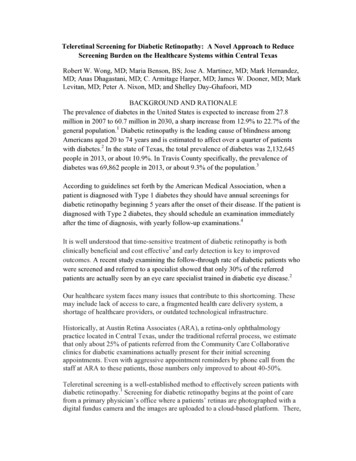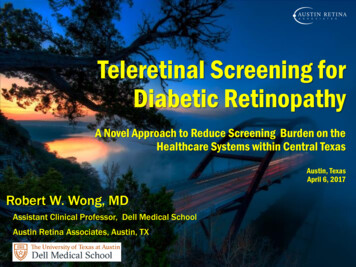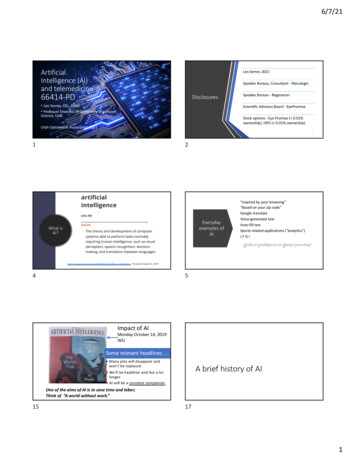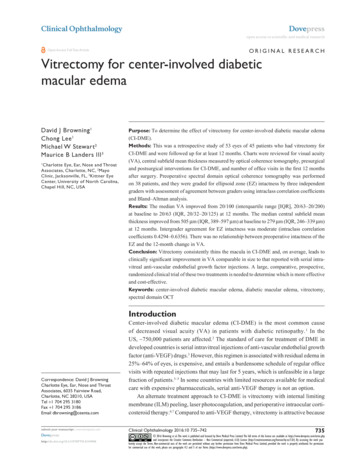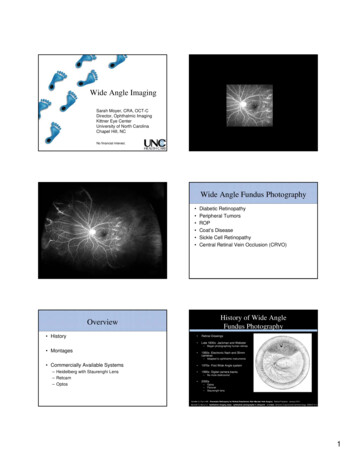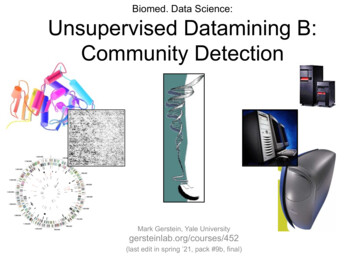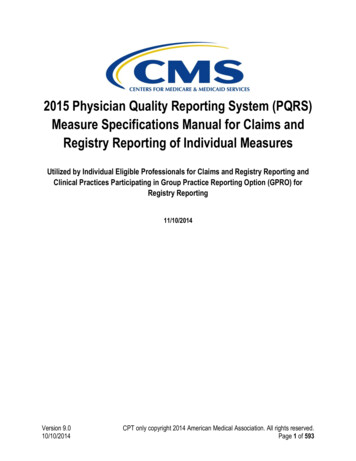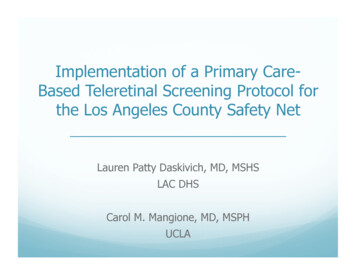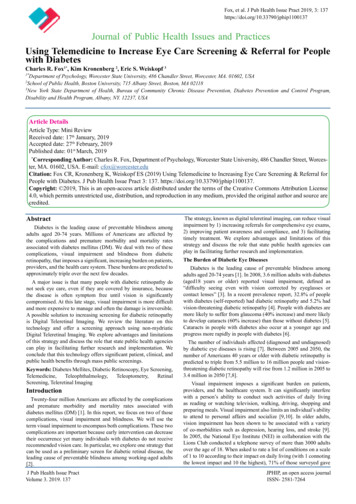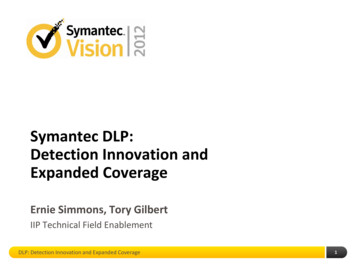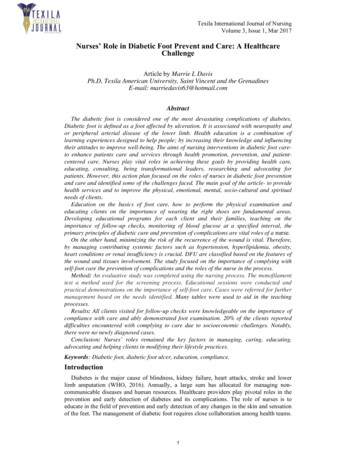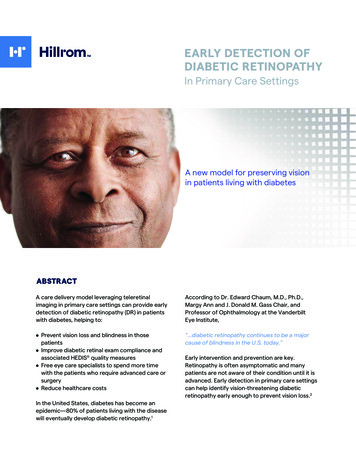
Transcription
EARLY DETECTION OFDIABETIC RETINOPATHYIn Primary Care SettingsA new model for preserving visionin patients living with diabetesABSTRACTA care delivery model leveraging teleretinalimaging in primary care settings can provide earlydetection of diabetic retinopathy (DR) in patientswith diabetes, helping to:According to Dr. Edward Chaum, M.D., Ph.D.,Margy Ann and J. Donald M. Gass Chair, andProfessor of Ophthalmology at the VanderbiltEye Institute, Prevent vision loss and blindness in thosepatients Improve diabetic retinal exam compliance andassociated HEDIS quality measures Free eye care specialists to spend more timewith the patients who require advanced care orsurgery Reduce healthcare costs“ diabetic retinopathy continues to be a majorcause of blindness in the U.S. today.”In the United States, diabetes has become anepidemic—80% of patients living with the diseasewill eventually develop diabetic retinopathy.11 EARLY DETECTION OF DIABETIC RETINOPATHYEarly intervention and prevention are key.Retinopathy is often asymptomatic and manypatients are not aware of their condition until it isadvanced. Early detection in primary care settingscan help identify vision-threatening diabeticretinopathy early enough to prevent vision loss.2
PROJECTIONS FOR DIABETIC RETINOPATHY IN tive U.S. DiabeticRetinopathy Growth1514.6MillionYearFrom 2010 to 2050, the number of Americans withdiabetic retinopathy is expected to nearly double, from 7.7million to 14.6 million. In general, minority populations aremore likely to develop diabetic retinopathy than whites inthe United States (Lanting et al., 2005; Spanakis andGolden, 2013; Varma et al., ION95PERCENT2 EARLY DETECTION OF DIABETIC RETINOPATHYCause among working-age adults, diabeticretinopathy is the leading cause of blindness,despite the availability of effectivetreatments.5By the year 2050, the projected number ofpatients who will be living with diabeticretinopathy.4Number of Americans who have diabetes,with 1.7 million new cases per year.3Early detection and treatment can reducecases of vision loss or blindness by up to95%,2 making early diagnosis critical beforediabetic retinopathy becomes advanced.
FEATURED EXPERTDR. EDWARD CHAUM, M.D., PH.D.Margy Ann and J. Donald M. Gass ChairProfessor of OphthalmologyVanderbilt Eye InstituteEdward Chaum, M.D., Ph.D., is the inaugural Margy Annand J. Donald M. Gass Chair, Professor of Ophthalmologyand Visual Sciences at the Vanderbilt Eye Institute inNashville, Tennessee. He is a retina surgeon and clinicianscientist whose work over the past two decades hasfocused on translating engineering concepts into newclinical care paradigms to improve ocular health. Dr.Chaum serves as consulting Chief Medical Officer for theRetinaVue care delivery model.THE CURRENT PROTOCOLPrimary care physicians typically refer patients withdiabetes to an eye care specialist for an annualretinal exam.Continuing with this care delivery model, however, isproblematic. Half of those referred to specialists don’tfollow through.6 The patient may not comprehend theimportance of the exam. When patients areasymptomatic, they don’t notice there is a problem, sothere is no sense of urgency. There are alsogeographic and socioeconomic challenges thatprevent many patients from complying with referrals.As a result, annual retinal exam compliance is low. 80% ofpeople with diabetes will eventually develop retinopathy,1and may need surgical intervention or injections to treatDR. It is important to catch the disease early, becausein later stages treatment options are more costly, moreinvasive, and less effective in preserving vision.Ophthalmologists struggle to keep up with the demand.Diabetes is an epidemic, and by 2025, more than 10million Americans will be living with diabetic retinopathy.4Yet, the number of ophthalmologists is shrinking, andby 2025, only 16,510 ophthalmologists will be availableto treat patients with severe eye disease. That’s 27% lessthan required, according to U.S. Department of Healthand Human Services.73 EARLY DETECTION OF DIABETIC RETINOPATHYManagement of patients diagnosed with diabetes in theU.S. is costly, 176 billion in direct medical costs withone-third paid by private insurance and two-thirds bygovernment healthcare services.8“Unfortunately, many cases of diabetic retinopathy areadvanced by the time I see them. Advanced DR can leadto diabetic macular edema, proliferative DR, and severevisual impairment and blindness. However, if identifiedearly, the disease process can be slowed and patientscan often be successfully managed together with closeobservation and good control of blood glucose, bloodpressure and lipids.” - Dr. Chaum
CHANGING THE PARADIGMThe current care delivery model is clearlyinadequate, as statistics indicate. A paradigm shift isnecessary in order to increase patient compliance withannual retinal examinations, and to decrease the numberof people suffering from vision loss and blindness as aresult of undiagnosed diabetic retinopathy.While care delivery models that use teleretinal imagingtechnology are not new and have been successfulworldwide,9 there have been significant barriers towidespread adoption in U.S. primary healthcare settings.In the past, retinal cameras were large, expensive andrequired patient dilation. And, teleretinal softwareplatforms and nationwide diagnostic services were rare.“It is very difficult for primary care physicians to performan adequate retinal examination through an undilatedpupil with a direct ophthalmoscope. Routine teleretinalassessments and early identification of DR in the primarycare setting will lead to both improved patient outcomesand reduced overall healthcare costs.” — Dr. ChaumIn 2015, the Welch Allyn(R) RetinaVue(R) care delivery modelwas introduced, designed specifically for primaryhealthcare settings. It includes three main components:1. Tabletop or handheld retinal cameras to obtain highquality retinal images. Image capture takes less thanfive minutes and generally does not require dilationfor about 85% of patients. Providers can choose thesimple and affordable RetinaVue 700 Imager, theworld’s most advanced handheld retinal camera.2. HIPAA-compliant, FDA-cleared, RetinaVueNetwork software transmits encrypted retinal imagesto your preferred eye specialist and managespopulation health data by clinic and patient. Thesoftware plan (priced per camera, per month)includes fully integrated, bi-directional interfaceswith EMRs to streamline documentation.3. Ophthalmologists and retina specialists at RetinaVue,P.C., interpret the retinal images and prepare acomprehensive diagnostic report and referral careplan, generally within one business day—completewith ICD codes, signature and license number.Professional medical services offered by RetinaVue,P.C., are priced on a per exam basis. Alternatively, youcan use your preferred eye specialist.4 EARLY DETECTION OF DIABETIC RETINOPATHY“The RetinaVue care delivery model is apatient-centered solution that can identify patientswith diabetic retinopathy in the primary care office. Theimages captured using the RetinaVue Imager clearlyshow the optic nerve and the macula, where the mostimportant pathology is typically located. Using this caredelivery model, a primary care provider can identifypatients at high risk for visual loss. The convenience andaffordability of the care delivery model permits timelyidentification and intervention earlier in the diseasecourse, ultimately resulting in better long-term patientoutcomes, and better patient management by theprimary healthcare provider.” — Dr. Chaum
EVERYONE BENEFITSA care delivery model that expands access to diabeticretinal exams in primary healthcare settings creates anopportunity where everyone benefits.For the Patient Offering diabetic retinal exams during routineprimary care office visits is a very convenient andaffordable way to ensure patients with diabetes getan annual retinal exam.The exam is comfortable, generally takes less thanfive minutes and is noninvasive.Early detection is critical to identify DR before itbecomes advanced.2Up to 95% of vision loss cases can be preventedwith early detection and treatment of DR.2For the Primary Care Provider Easily added to standard patient flow.Adds a valuable service to their standard of care.Accurate documentation of chronic conditionshelps inform care planning, care delivery,appropriate coverage and quality performance.10Achieve up to 90% documented compliance in 12months while improving quality-measure scores(e.g., HEDIS , NCQA , STAR, and CMS QualityPayment Program) and associated financialincentives.5 EARLY DETECTION OF DIABETIC RETINOPATHYFor the Eye SpecialistAllows ophthalmologists to focus on deliveringhigher-value services and/or sight-saving procedures topatients who need expert care.“There is agreement among primary care physicians,endocrinologists, ophthalmologists and optometriststhat checking patients with diabetes for diabeticretinopathy is both clinically important andcost-effective. While many patients follow up with eyecare specialists, half of diabetic patients do not receiveannual exams. Therefore, routine exams and earlydetection of DR is important for all diabetes patients.Visual outcomes for patients with DR is always going tobe better if DR is identified early and medicalintervention and treatment strategies are institutedearlier in the disease process.” — Dr. Chaum
RESOURCES1. American Academy of Ophthalmology Retina/VitreousPanel. Preferred Practice Pattern Guidelines. DiabeticRetinopathy. San Francisco, CA: American Academy ofOphthalmology; 2014. Available at: www.aao.org/ppp.Accessed May 30, 2017.2. National Eye Institute. Facts About Diabetic EyeDisease. Available at: https://nei.nih.gov/health/diabetic/retinopathy. Accessed May 30, 2017.3. Centers for Disease Control and Prevention. NationalDiabetes Statistics Report: Estimates of Diabetes andIts Burden in the United States, 2014. Atlanta, GA: U.S.Department of Health and Human Services; 2014.Available at: https://www.cdc.gov/diabetes. AccessedMay 30, 2017.4. National Eye Institute. Diabetic Retinopathy Tables.Available at: ed May 31, 2017.5. Centers for Disease Control and Prevention. VisionHealth Initiative (VHI). Common Eye Disorders. Availableat: html. Accessed May 31, 2017.6. Sloan FA, Brown DS, Carlisle ES, Picone GA, LeePP. Monitoring visual status: why patients do ordo not comply with practice guidelines. HealthServ Res. 2004;39(5):1429–1448. doi: 10.1111/j.14756773.2004.00297.xRajput Y, Fisher M, Gu T, et al. Patient and providerperspectives: why are patients with diabetes mellitusnoncompliant with dilated eye exams? Invest OphthalmolVis Sci. June 2015;56:1440.Lee DJ, Kumar N, Feuer WJ, et al. Dilated eye examinationscreening guideline compliance among patients withdiabetes without a diabetic retinopathy diagnosis: therole of geographic access. BMJ Open Diabetes Res Care.2014;2(1):e000031. doi:10.1136/bmjdrc-2014-00031Rawi S, Wendling M. Improving population health via aquality measurement analysis: diabetic eye exam. Posterpresented at: The Prolog II Presentation Day; July 16,2015; University of South Florida, Tampa, Fla.6 EARLY DETECTION OF DIABETIC RETINOPATHY7. U.S. Department of Health and Human Services,Health Resources and Services Administration, NationalCenter for Health Workforce Analysis. 2016. Nationaland Regional Projections of Supply and Demand forSurgical Specialty Practitioners: 2013-2025. Rockville,Maryland. specialty-report.pdf8. Centers for Disease Control and Prevention. ChronicDisease Overview. Available at: http://www.cdc.gov/chronicdisease/overview. Accessed May 31, 2017.9. Williams GA, Scott IU, Haller JA, Maguire AM, MarcusD, McDonald HR. Single-field fundus photography fordiabetic retinopathy screening: a report by the AmericanAcademy of Ophthalmology. Ophthalmology. 2004;111(5):1055–1062.10. Mansberger SL, Gleitsmann K, Gardiner S, et al.Comparing the effectiveness of telemedicine andtraditional surveillance in providing diabetic retinopathyscreening examinations: a randomized controlled trial.Telemed J E Health. 201;19(12):942–948. doi: 10.1089/tmj.2012.0313.11. Understanding the Role of HCCs in Risk-AdjustmentPrograms; A Comprehensive Primer for HierarchicalCondition Categories, 2017 Advisory Board, www.advisory.com
For more information, please visit retinavue.com or contact your local distributoror Hillrom sales representative at 1-800-535-6663.hillrom.com 2019 Welch Allyn.ALL RIGHTS RESERVED.7 EARLY DETECTION OF DIABETIC RETINOPATHYMC1601080023846Ver C2019-07
DIABETIC RETINOPATHY In Primary Care Settings A care delivery model leveraging teleretinal imaging in primary care settings can provide early detection of diabetic retinopathy (DR) in patients with diabetes, helping to: Prevent vision loss and blindnes
